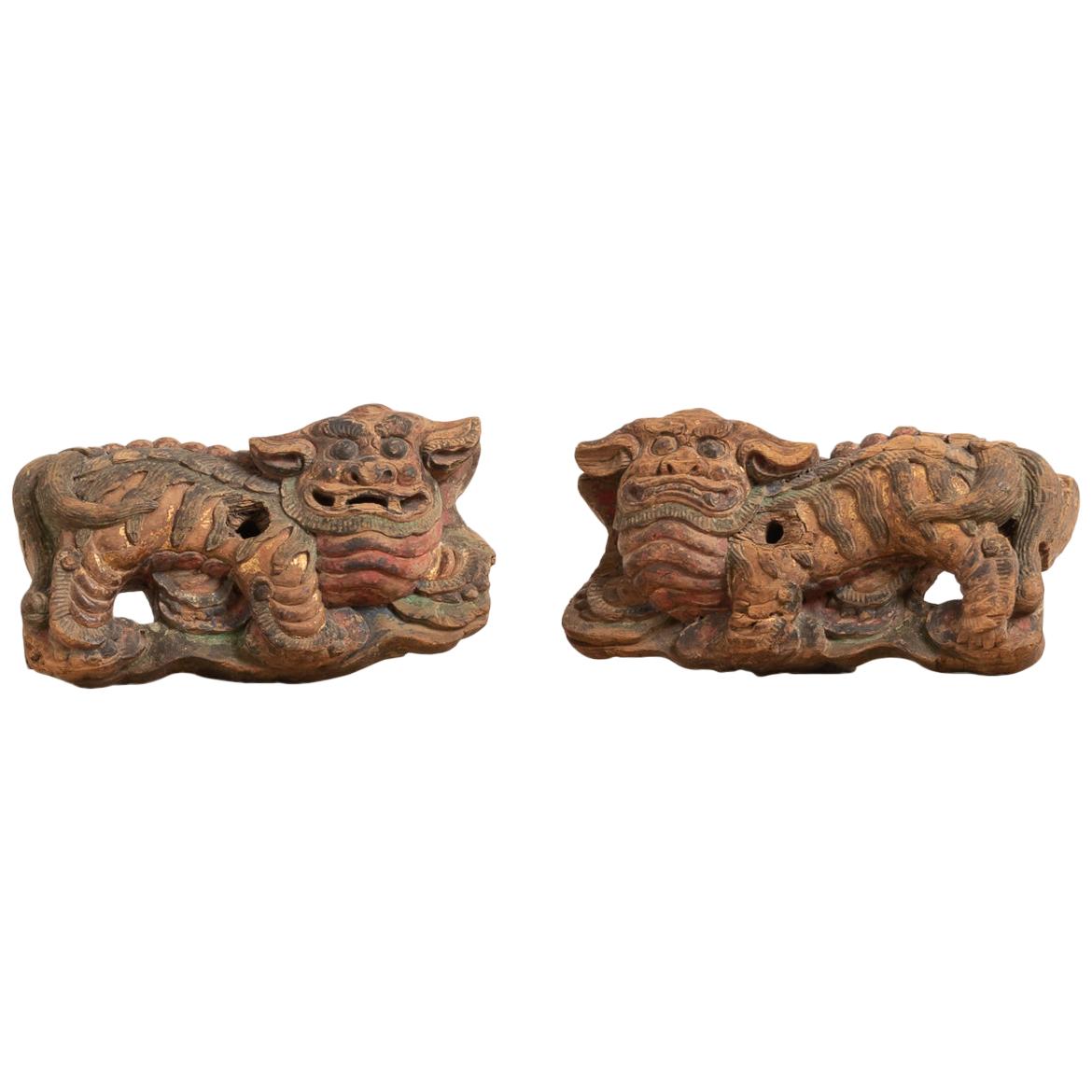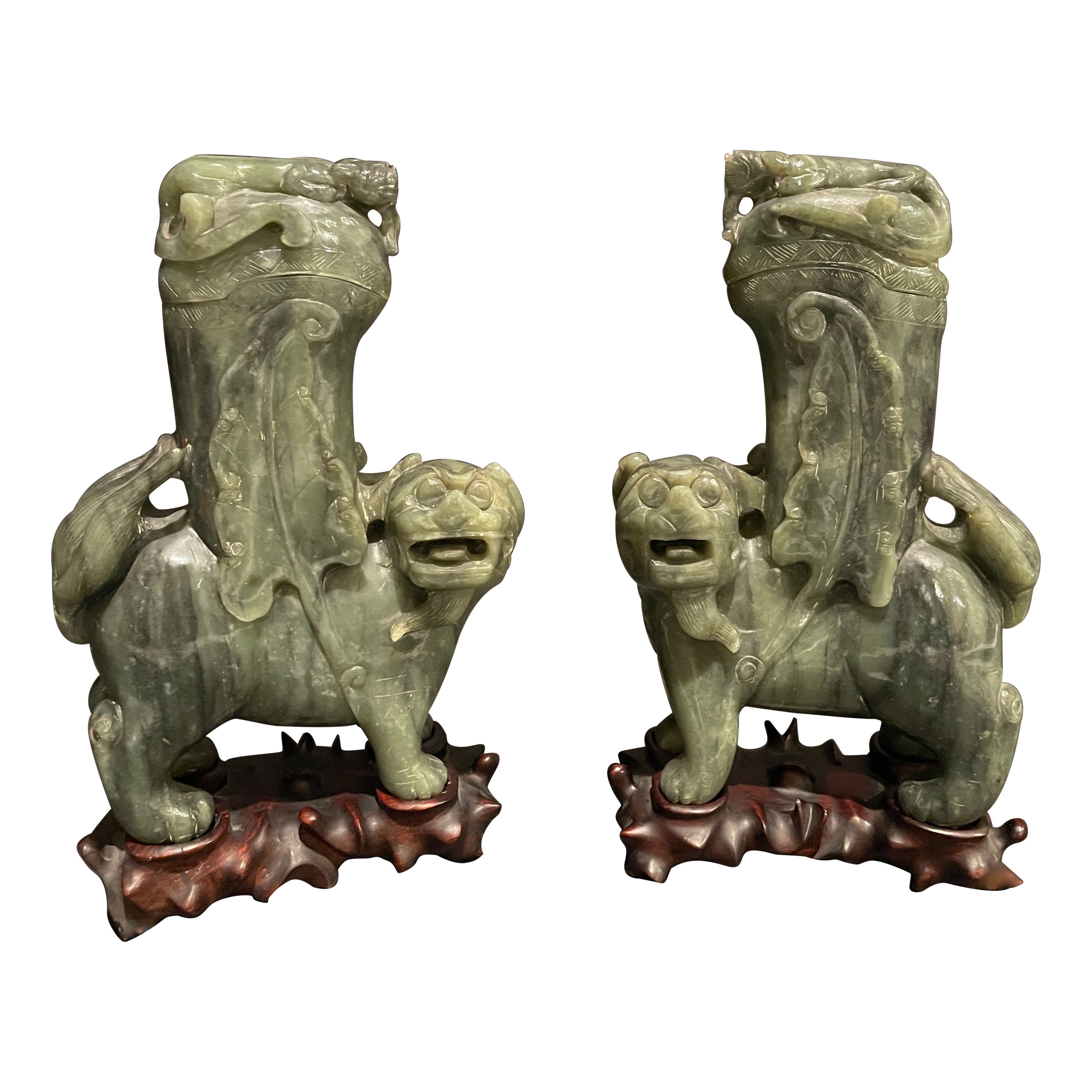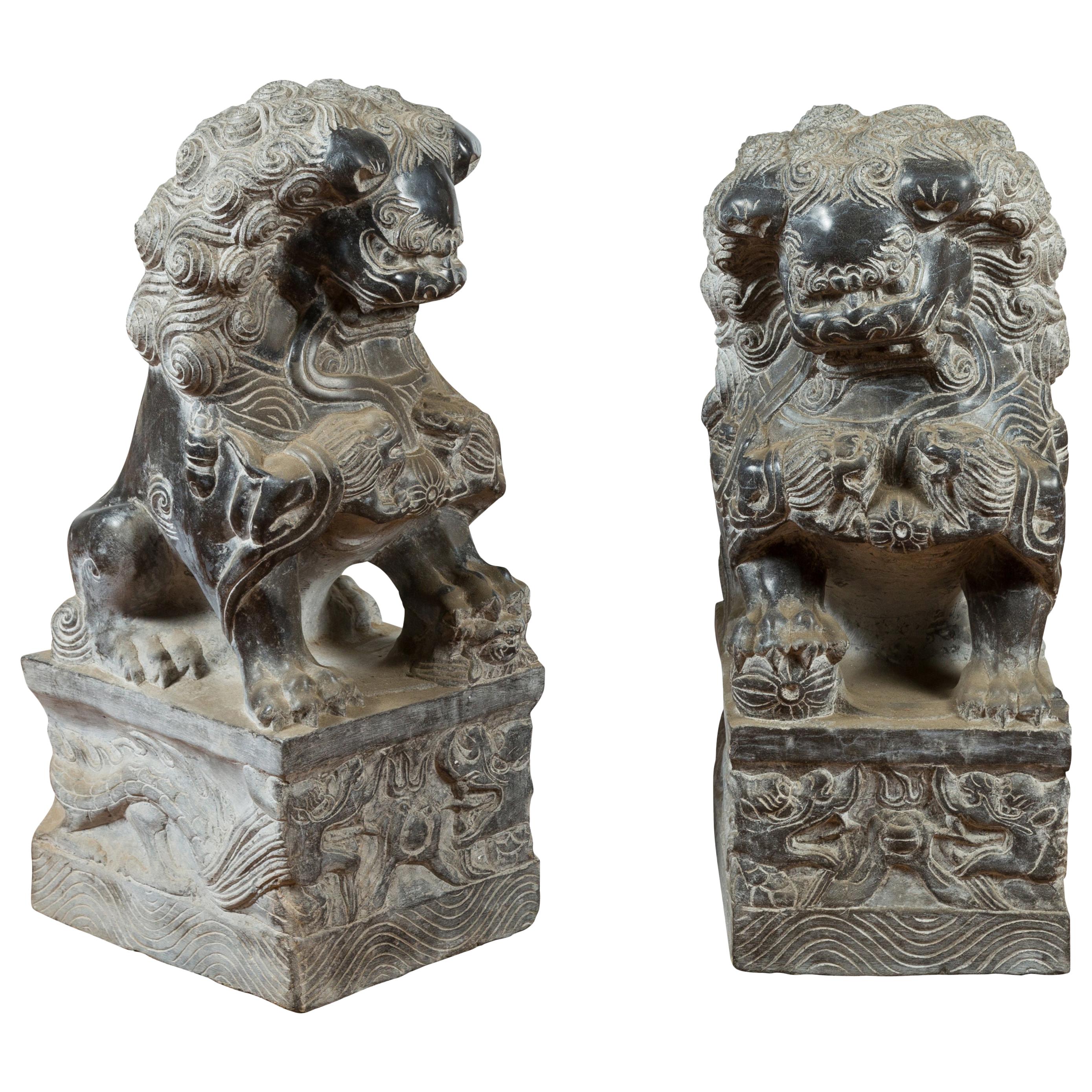Items Similar to Pair of Guardian Lions / Fo Dogs / Shizi, White Ceramic, China, Qing Era, 19th
Want more images or videos?
Request additional images or videos from the seller
1 of 21
Pair of Guardian Lions / Fo Dogs / Shizi, White Ceramic, China, Qing Era, 19th
About the Item
Rare pair of Important Guardian Lions / Fo Dogs / Shizi in ceramic with cracked white enamel.
China, Qing Dynasty, 19th century
Each Fo Dog / Shizi is seated on a wooden base, its mouth open with a beautiful expression, a necklace of bells around its neck, the male (the Yang) with its paw placed on a decorated ball called xiù qiú (which, in a imperial context, represents supremacy over the world), the female (the Ying) with her paw placed on her puppy (representing the cycle of life, education). Symbolically, the female protects those who reside within, while the male protects the structure.
These very stylized Guardian lions were supposed to protect the house from harmful influences.
In very good condition.
Dimensions:
height 50 cm
width 20 cm
depth 22 cm
- Dimensions:Height: 19.69 in (50 cm)Width: 7.88 in (20 cm)Depth: 8.67 in (22 cm)
- Sold As:Set of 2
- Style:Chinese Export (Of the Period)
- Materials and Techniques:
- Place of Origin:
- Period:
- Date of Manufacture:19th Century
- Condition:Wear consistent with age and use. In very good condition.
- Seller Location:VÉZELAY, FR
- Reference Number:1stDibs: LU6868237749212
About the Seller
5.0
Platinum Seller
These expertly vetted sellers are 1stDibs' most experienced sellers and are rated highest by our customers.
Established in 2017
1stDibs seller since 2022
19 sales on 1stDibs
Typical response time: <1 hour
- ShippingRetrieving quote...Ships From: Vézelay, France
- Return PolicyA return for this item may be initiated within 3 days of delivery.
More From This SellerView All
- Asian Sculpture / Okimono with Lion and Crows, Japan, Meiji Era, circa 1880Located in VÉZELAY, FRRare and important Japanese sculpture / statue / okimono in blackened and carved wood, depicting 1 lion, 2 birds (crows or other birds of prey) and 1 snake held in the claws of one o...Category
Antique 1880s Japanese Meiji Sculptures and Carvings
MaterialsWood
- Asian Pedestal Table in Carved Wood on a Mythological Theme, circa 1890Located in VÉZELAY, FRSuperb Asian high pedestal table in solid wood richly carved. The tripod base is composed of 3 heads of dragons / demons. In the center, a dragon walks on clouds. He is surround...Category
Antique 1890s Vietnamese Chinese Export Pedestals
MaterialsWood
- Pair of Gothic Jesters Lamps, France, 19th CenturyLocated in VÉZELAY, FRPair of carved lamps in walnut figuring hilarious jesters / clowns, seated on a column. Neo-gothic / Gothic revival style, France, 19th century Excellent condition, cleaned wo...Category
Antique 19th Century French Gothic Revival Table Lamps
MaterialsWood, Walnut
- Indochinese Tray Carved with Dragons, circa 1900Located in VÉZELAY, FRSuperb Indochinese table / serving tray in carved wood. Very elaborate sculpture with a mythological theme (dragons). Good manufacturing quality. Asia, French Indochina (Vietnam), ...Category
Antique Early 1900s Vietnamese Chinoiserie Sculptures and Carvings
MaterialsWood
- Important Chinese blue ceramic lamp with butterflies, Quing Thongzhi, China 1865Located in VÉZELAY, FRImportant Chinese lamp in blue ceramic decorated with butterflies and flowers. China. QING dynasty, Tongzhi era, 1861-1875 Blackened wooden base In excellent condition, electricity ...Category
Antique 1860s Chinese Chinese Export Table Lamps
MaterialsPorcelain, Wood, Ceramic
- Chinese porcelain lamp decorated with flowers and peacocks, China, Early 20thLocated in VÉZELAY, FRAsian porcelain vase mounted as a lamp. Floral and animal decor: peacocks. China, first part of the 20th century. Very good condition, electricity OK. Dimensions: Height:40cm Diamet...Category
Early 20th Century Chinese Chinese Export Table Lamps
MaterialsMetal, Brass
You May Also Like
- A pair of 19th Century carved Foo temple dogs or Chinese guardian LionsLocated in London, GBChinese guardian lions, or imperial guardian lions, are a traditional Chinese architectural ornament. Typically made of stone, they are also known as stone lions or shishi (石獅; shíshī). They are known in colloquial English as lion dogs or foo dogs / fu dogs. The concept, which originated and became popular in Chinese Buddhism, features a pair of highly stylized lions—often one male with a ball and one female with a cub—which were thought to protect the building from harmful spiritual influences and harmful people that might be a threat. Used in imperial Chinese palaces and tombs, the lions subsequently spread to other parts of Asia including Japan (see komainu), Korea, Philippines, Tibet, Thailand, Myanmar, Vietnam, Sri Lanka, Nepal, Cambodia, Laos, and Malaysia. There has been extensive interaction between Chinese mythology and Confucianism, Taoism, and Buddhism. Elements of pre-Han dynasty mythology such as those in Classic of Mountains and Seas were adapted into these belief systems as they developed (in the case of Taoism), or were assimilated into Chinese culture (in the case of Buddhism). Elements from the teachings and beliefs of these systems became incorporated into Chinese mythology. For example, the Taoist belief of a spiritual Paradise became incorporated into mythology as the place where immortals and deities used to dwell. Sometimes mythological and religious ideas have become widespread across China's many regions and diverse ethnic societies. In other cases, beliefs are more limited to certain social groups, for example, the veneration of white stones by the Qiang. One mythological theme that has a long history and many variations involves a shamanic world view, for example in the cases of Mongolian shamanism among the Mongols, Hmong shamanism among the Miao people, and the shamanic beliefs of the Qing dynasty from 1643 to 1912, derived from the Manchus. Politically, mythology was often used to legitimize the dynasties of China, with the founding house of a dynasty claiming a divine descent. Mythology and philosophy. Further information: Chinese philosophy True mythology is distinguished from philosophical treatises and theories. Elaborations on the Wu Xing are not really part of mythology, although belief in five elements could appear. The Hundred Schools of Thought is a phrase suggesting the diversity of philosophical thought that developed during the Warring States of China. Then, and subsequently, philosophical movements had a complicated relationship with mythology. However, as far as they influence or are influenced by mythology, divides the philosophical camps into two rough halves, a Liberal group and a Conservative group. The liberal group being associated with the idea of individuality and change, for example as seen in the mythology of divination in China, such as the mythology of the dragon horse that delivered the eight bagua diagrams to Fu Xi, and methods of individual empowerment as seen in the Yi Jing (Book of Changes). The Liberal tendency is towards individual freedom, Daoism, and Nature. The relationship of the Conservative philosophies to mythology is seen in the legendary Nine Tripod Cauldrons, mythology about the emperors and central bureaucratic governance, Confucianism, written histories, ceremonial observances, subordination of the individual to the social groups of family and state, and a fixation on stability and enduring institutions. The distinction between the Liberal and Conservative is very general, but important in Chinese thought. Contradictions can be found in the details, however these are often traditional, such as the embrace by Confucius of the philosophical aspects of the Yi Jing, and the back-and-forth about the Mandate of Heaven wherein one dynasty ends and another begins based according to accounts (some of heavily mythological) where the Way of Heaven results in change, but then a new ethical stable dynasty becomes established. Examples of this include the stories of Yi Yin, Tang of Shang and Jie of Xia or the similar fantastic stories around Duke of Zhou and King Zhou of Shang. Mythology exists in relationship with other aspects of society and culture, such as ritual. Various rituals are explained by mythology. For example, the ritual burning of mortuary banknotes (Hell Money), lighting fireworks, and so on. A good example of the relationship of Chinese mythology and ritual is the Yubu, also known as the Steps or Paces of Yu. During the course of his activities in controlling the Great Flood, Yu was supposed to have so fatigued himself that he lost all the hair from his legs and developed a serious limp. Daoist practitioners sometimes incorporate a curiously choreographed pedal locomotion into various rituals. Mythology and practice, one explains the other: in these rituals, the sacred time of Yu merges with the sacral practice of the present. Various ideas about the nature of the earth, the universe, and their relationship to each other have historically existed as either a background or a focus of mythologies. One typical view is of a square earth separated from a round sky by sky pillars (mountains, trees, or undefined). Above the sky is the realm of Heaven, often viewed of as a vast area, with many inhabitants. Often the heavenly inhabitants are thought to be of an "as above so below" nature, their lives and social arrangements being parallel to those on earth, with a hierarchical government run by a supreme emperor, many palaces and lesser dwellings, a vast bureaucracy of many functions, clerks, guards, and servants. Below was a vast under ground land, also known as Diyu, Yellow Springs, Hell, and other terms. As time progressed, the idea of an underground land in which the souls of the departed were punished for their misdeeds during life became explicit, related to developments in Daoism and Buddhism. The underground world also came to be conceived of as inhabited by a vast bureaucracy, with kings, judges, torturers, conductors of souls, minor bureaucrats, recording secretaries, similar to the structure of society in the Middle Kingdom (earthly China). Chinese temple Dogs...Category
Antique 1860s Chinese Chinese Export Sculptures and Carvings
MaterialsHardwood
- Pair of Chinese Guardian Lion Dogs, c. 1850Located in Chicago, ILThis pair of monumental Fu-Lions, also known as shizi, once would have flanked the entrance to a Qing-dynasty home in China’s Shanxi province. One has a pearl under its foot, and the...Category
Antique Mid-19th Century Chinese Qing Sculptures and Carvings
MaterialsLimestone
- 19th Century Chinese Guardian Lions in Original ConditionLocated in Kramfors, SEChinese guardian lions in original condition. The lions are made from wood and were handmade sometime during the 19th century in China. The guard...Category
Antique 19th Century Chinese Chinese Export Sculptures and Carvings
MaterialsWood
- Pair Of Chinese Hardstone Guardian LionsLocated in Norwood, NJPair of hand carved Chinese Jade hardstone Foo Lions or Fu Dogs. This pair of Chinese spinach jade appears to be a nephrite, covered vases having a figural foo lion design with raise...Category
Antique Late 19th Century Chinese Chinese Export Sculptures and Carvings
MaterialsJade
- Chinese Qing Dynasty 19th Century Carved Stone Foo Dog Guardian Lion SculptureLocated in Yonkers, NYA Chinese Qing Dynasty period carved stone foo dog guardian lion from the 19th century, on square base. Created in China during the Qing Dynasty, this st...Category
Antique 19th Century Chinese Qing Statues
MaterialsStone
- Pair of Chinese Black Marble Contemporary Facing Foo Dogs Guardian LionsLocated in Yonkers, NYA pair of contemporary Chinese black marble left and right facing foo dogs guardian lions on rectangular bases. Created in China during the 21st century, this pair of black marble gu...Category
21st Century and Contemporary Chinese Sculptures and Carvings
MaterialsMarble
Recently Viewed
View AllMore Ways To Browse
Japanese Prayer Bell
Japanese Bronze Temple Bell
Vintage Dragon Sculpture
Woodblock Island
Chinese Wood Block
Wooden Buddha Burma
Antique Chinese Buddha Statue
Large Carved Wooden Buddha
Wooden Buddhism
Large Sitting Buddha
Jade Toggle
Chinese Rat
Japanese Kimono Doll
Lavender Jade Sculpture
Bone Okimono Japanese
Lotus Blossom Altar
Marotte Dolls
Shrine Guardian Dog





